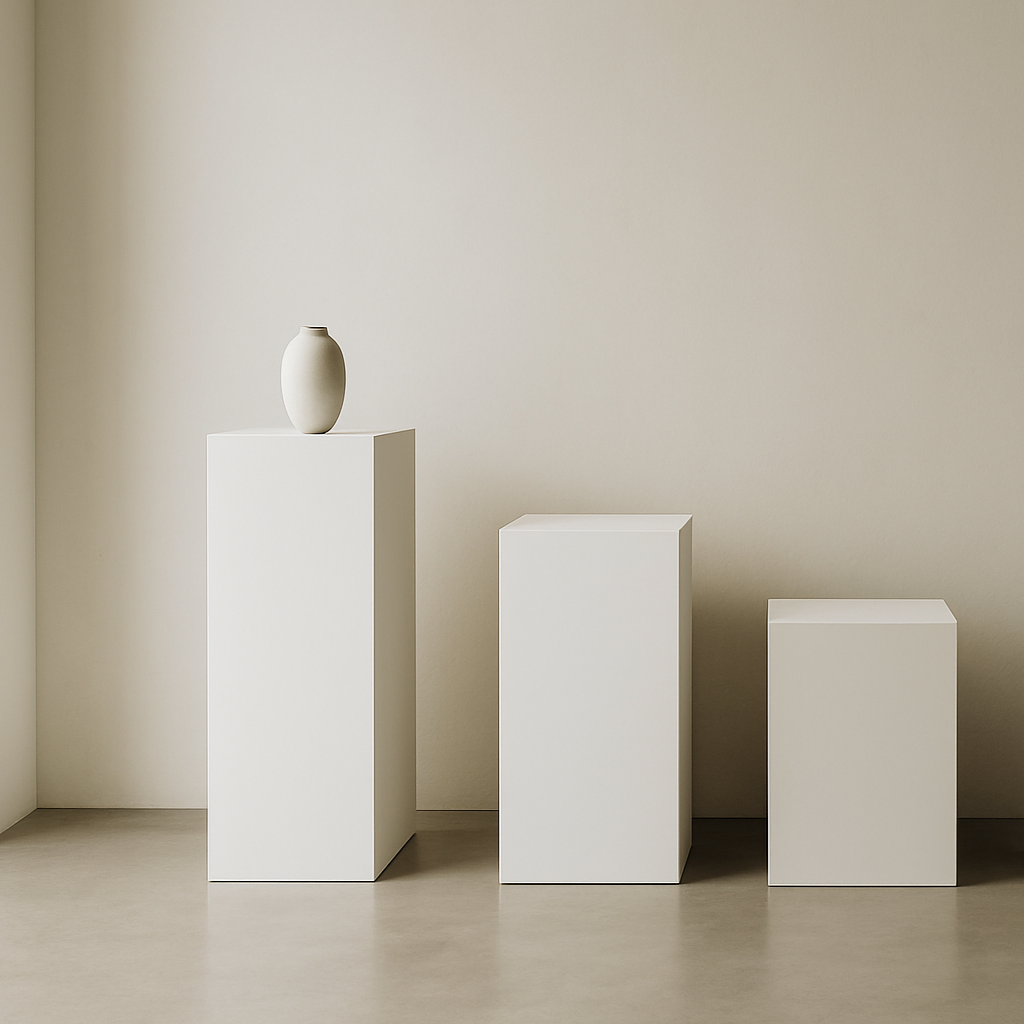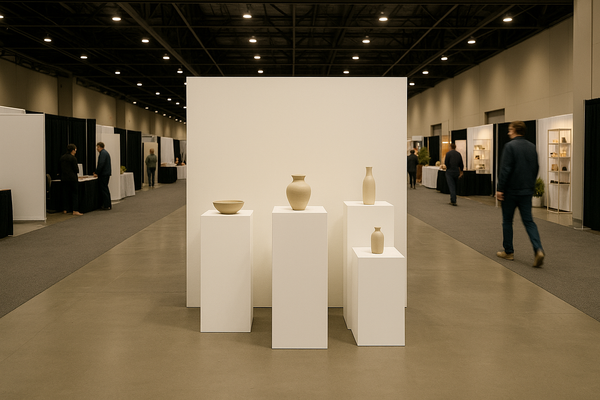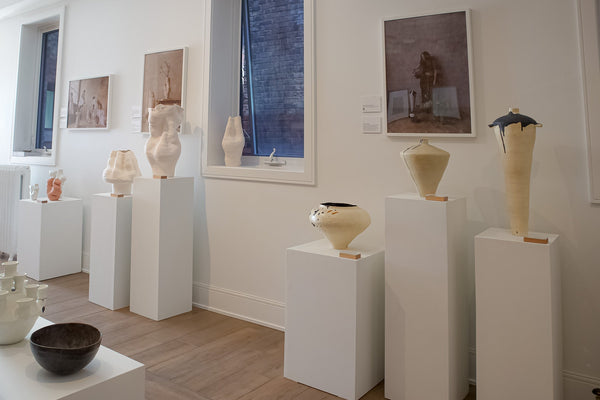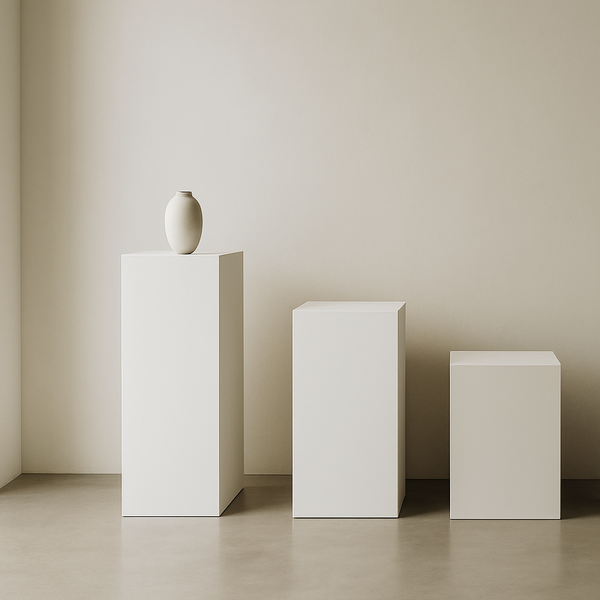If you’re shopping for display blocks, you’ll see both plinth and pedestal used. They’re related—but not identical. Here’s the practical guide to choosing the right one for your piece, space, or shoot.
Quick definitions (practical, not fussy)
Plinth
A solid, usually rectangular block with clean planes. Purpose-built to disappear so the object reads first.
Pedestal
A stand that may include a base, column, and top—often more articulated or decorative, with a little “story” of its own.
When to use a plinth
Galleries & museums
Neutral, modern support that doesn’t compete with the work. If the brief is “let the piece breathe,” a plinth is your friend.
Retail product shots & windows
Matte, minimal surfaces keep the attention on the product and photograph cleanly. Nothing steals the spotlight—or throws unwanted reflections.
Pop-ups & trade booths
Quick, modular layout. Multiple heights create sightlines and help guide traffic through your space. Easy to reconfigure between days or activations.
Homes & studios
For sculpture, vessels, books, or plants, a plinth acts like a quiet stage that tidies the composition.
When to use a pedestal
Heritage interiors
When detail or classic character is part of the story (think mouldings, gallery rails, parquet floors). A pedestal’s base/column/top can echo the architecture.
Sculpture with tall proportions
Columns can emphasize verticality or complement classical forms. If your piece wants a dialogue with tradition, a pedestal speaks the language.
Focal points
In an entry, at the end of a corridor, or beside a mantle, a pedestal adds a deliberate “moment” even before the object is placed.
Material & finish
-
Matte white plinths photograph cleanly and reduce glare—ideal for product work and contemporary spaces.
-
Birch or wood-tone adds warmth while staying minimal; great for retail, lifestyle shoots, and residential styling.
-
Dark finishes (slate/charcoal) make pale objects pop and carve a crisp silhouette in bright rooms.
-
Stone-look or microcement brings weight and tactility without visual noise—good for installations needing a grounded feel.
Tip: Keep tops the same finish across a group for cohesion, even if bases vary.
Sizing basics (start here)
Top size
Give your object at least 1–2 in (2.5–5 cm) breathing room on all sides.
-
Small objects (cups, small vessels): top 8–10 in (20–25 cm)
-
Medium objects (busts, vases, lamps): top 12–14 in (30–36 cm)
-
Large objects (sculpture, stacked displays): top 16–20 in (41–51 cm)
Height
Use height to set the viewing angle, not just “tall vs. short.”
-
24–30 in (61–76 cm) for large objects (they already hold presence)
-
36–42 in (91–107 cm) for medium objects
-
42–48 in (107–122 cm) for small objects or retail windows where eye-level matters
Quick rule: Aim for the centre of interest to sit around 52–58 in (132–147 cm) from the floor in gallery or retail settings.
Layout tips
-
Trios win. Three heights create a natural composition and a clear hero.
-
Stagger depth. Don’t line everything up—overlap by a few inches to add dimension and flow.
-
Leave air. Negative space sells the object; resist the urge to fill every gap.
-
Anchor the group. Keep a consistent gap from walls (e.g., 6–10 in / 15–25 cm) and align at least one edge across the set for calm.
-
Guide the eye. Put your tallest plinth slightly off-centre so the sightline rises then resolves on the hero object.
Common mistakes (and easy fixes)
-
Top too tight. If the object nearly touches the edge, size up one tier.
-
All one height. Flattened sightlines feel like a warehouse. Mix heights to create rhythm.
-
Glossy chaos. Shiny tops reflect labels and lights. Go matte for camera-friendliness.
-
Over-styling. If you love the base more than the piece, switch from pedestal to plinth.
FAQ
Do plinths and pedestals hold the same weight?
Not always—construction varies. Check weight ratings with your maker, especially for stone, cast, or multi-object stacks.
Can I mix plinths and pedestals?
Yes, if there’s a clear hierarchy. Use a pedestal for your statement piece and support it with quieter plinths around.
What’s the best all-round setup for a pop-up?
A trio of matte white plinths (small/medium/tall) plus one wood-tone piece for warmth covers most product categories and photo needs.
The takeaway
-
Choose a plinth when you want the cleanest, most modern read of the object.
-
Choose a pedestal when the base should add character or extend a classical line.
If you’d like help sizing or planning a layout, we can map heights and tops to your exact pieces—then build a set that photographs beautifully and works hard in real life. Shop plinths, browse rentals, or get a quick quote, and we’ll recommend a trio that suits your space and timeline.




